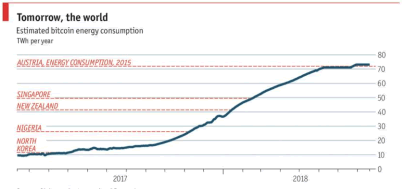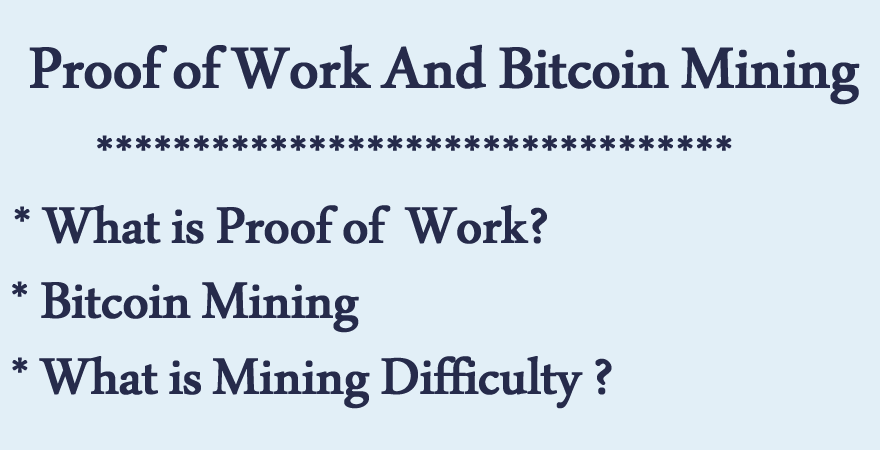The Consensus Algorithm Behind the hash power of Bitcoin.
Introduction
It's easy to say that the majority of people reading this post right now have heard about bitcoin mining or any other crypto-related mining, either on the Internet or from someone who is has a crypto-related experience and crypto passion. No doubt you have questions and wish to know more about cryptocurrencies and bitcoin mining? This article is designed to explain the mechanics of bitcoin mining and other crypto-related mining(using Bitcoin as a model)to a very smaller detail. So stay tuned let's study together
Proof of Work
(commonly abbreviated to PoW) is a form of cryptographic zero-knowledge proof in which one party (the prover) proves to others (the verifiers) that a certain amount of computational effort has been expended for some purpose. Verifiers can subsequently confirm this expenditure with minimal effort on their part.
The proof of work mechanism has become very popular since its adoption in the bitcoin network back in 2008 by Satoshi Nakamoto, this protocol quickly grew to fame after bitcoin success and has been implored on other top networks like Litecoin and Etherum.
This protocol is the core of the bitcoin network, new blocks are created and consensus reached when miners compete and successfully solve a cryptographic puzzle using heavy computation power. Basically, these cryptographic puzzles act as the decisive feature of the bitcoin network. Bitcoin has better trustworthiness because it is protected by heavy computation. Bitcoins are mined using the Hashcash proof-of-work function by individual miners and verified by the decentralized nodes(Computers around the world) in the bitcoin network.
The level of difficulty is periodically adjusted to keep the block time around a target time, the reason for this is to retain the credibility and accuracy of the transactions if the problem is too easy it is prone to vulnerabilities, DoS attacks, and spam and the solution also needs to be easily checked, because not all nodes are capable of analyzing if the calculations are correct so, maintaining a substantial level of difficulty is crucial to the network's credibility and security and the nodes do just that.
Transactions that occur in the bitcoin network are stored and recorded in an open-source distributed ledger known as Blockchain. This ledger stores and arranges the transactions into blocks in the network that have to be solved using heavy computing power to confirm and arrange blocks. Confirming block and transactions in the bitcoin network is carried out by miners, the process of validating transactions is referred to as Mining.
What do I mean by all these, kindly follow on the next frame......
Sample Simulation on how bitcoin mining and POW works.
In this simulation, we are going to use Alice, Becks, and David as bitcoin Minners who are looking to solve cryptographic puzzles and earn newly created bitcoins as a reward.
In this simulation, we are going to take Alice, Becks, and David as X1, X2, and X3 respectively.
All right let go...
We have Alice, Beck, and David as Bitcoin Minner who are looking to earn some bitcoins as miners, the process goes this way
The Bitcoin network servers send out a puzzle to miners in this case(Alice, Beck, and David), and each time a new puzzle is sent, the level of difficulty is periodically adjusted to keep the network safe and running.
Alice, Beck, and David receive this puzzle and start working on them using their supercomputers and heavy servers.
Alice, Becks, and David as X1, X2, and X3 respectively send their solutions back to the bitcoin network for validation.
The bitcoin networks confirm solutions received from the miners Alice, Becks, and David as X1, X2, and X3 respectively.
According to the reference image above, X2(Becks) correctly solves the puzzle after validation from the network. However, there could be more than a single correct solution and rewards will be shared among the miners who got verified.
immediately after confirmation and validation rewards(Newly minted bitcoins) are sent to X2(Becks).
Easy right I believe this much simpler to understand, this whole process happens fast and automated, this means once a new cryptographic puzzle is solved a new block is created and this happens every ten minutes.
Challenges of Bitcoin/Cryptocurrency Minners
Bitcoin mining over the years has not been free of some minor limitations and challenges, below are some of the mining limitations of BITCOIN.
- Heavy Energy Consumption
The cost of mining cryptocurrencies is one of the major factors that any intending miner must consider, creating a new block and solving cryptographic puzzles requires heavy computation power which is powered and active 24/7. In fact, crypto mining energy consumption has now become so significant that itis beginning to make a measurable impact upon the total global energy consumption and greenhouse gas emission.
This enormous energy consumption is demonstrated in Figure Two and in the following graph below:

Minning Conslodiation due to costs of electricity and High cost of mining equipment. Mining activities are highest in china due to its low electricity rates as a result crypto mining has become somewhat centralized.
Security of crypto Mining
Advantages of the POW consensus algorithm
The POW protocol provides a lot of security and stability to the bitcoin network and serves as the backbone for running active nodes. The POW protocol also provides benefits like-
Mining capabilities
Miners are rewarded for validating transactions using the proof of work protocol. When miners expand their computing powers in solving block puzzles, with the formation of new blocks and puzzle solved, the miners are rewarded with new bitcoins.
Defense from DoS attacks.
The proof of work consensus protects the bitcoin network from numerous attacks like the Dos attack that aims at dulling the system and with heavy irrelevant loads making it unresponsive to a relevant request. To explain this kind of attack better, it like a coffee shop with lots of bystanders at the door, this crowded entrance makes it difficult for the real customers to make their way inside the shop. The PoW algorithm imposes some limits on actions in the network. They need a lot of effort to be executed. An efficient attack requires a lot of computational power and a lot of time to do the calculations. Therefore, the attack is possible but kind of useless since the costs are too high.
The issue of double-spending
The issue of double-spending has been around for a very long time in the traditional system, where banks authorize duplicate transactions that are never reversed. On the contrary, the proof of work protocol provides immunity to this problem. Whenever a transaction is initiated, miners validate and confirm these transactions along with their unique timestamps are added to a new block, this process makes it difficult to duplicate the transaction.
I believe I have been able to make comprehensive homework on crypto mining, you can comment on this post and air your views so we can learn together.
Don't forget to do your homework lol
Thanks for reading up to this point guys and I hope you enjoyed my #cryptoprofessor homework.
This post is made in response to the #cryptoacademy program and the #cryptoprofessor homework by @besticofinder.

Subscribe:::Discord.
:::Whatsapp :::join trail




Hello @whitestallion,
Thank you for submitting the homework task 4 ! It was a very informative read ! I really love how you have explained how PoW works with a nice example. Keep up the good work ! [9]
Thank you
@besticofinder me comunico con usted por que no reviso mi tarea de la semana 3 https://steemit.com/hive-108451/@risedaniel/publicacion-de-tarea-de-la-semana-3-de-crypto-academy-para-besticofinder-tipos-de-cryptocomercios
support me
vote my post
Thanks for the classes@bestcofinder, you really doing a great job.
Support me. I am new here
Vote my post
Support me. I am new here
vote my post
Thank you for your work on steem greeters project.